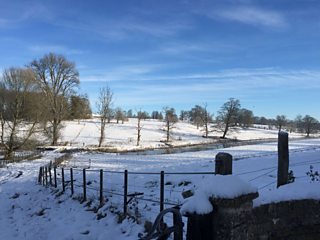Everything you need to know about Winterwatch 2018
Chris Hitchings
主播大秀 Springwatch Digital Team
Winterwatch is back!
Winterwatch returns to 主播大秀 Two at the end of January - broadcasting live from its home on the National Trust’s Sherborne Park Estate in the heart of the Cotswold countryside, chosen as ‘the Watches’ first ever year-round location for the fantastic variety of habitats and wildlife to be found there, and because the mix of woodland, farmland and parkland (and the species that live in it), is an microcosm of the kind of British countryside that is accessible to most people in the UK.
When is it on TV?
Winterwatch starts on Monday 29th January. There will be four episodes, all on 主播大秀 Two. On Monday and Thursday you can join us from 9pm. On Tuesday and Wednesday you can watch Winterwatch at 8pm.
Who are the presenters?
Chris Packham and Michaela Strachan will be based at our cosy barn on the estate, bringing updates from the remote cameras rigged throughout the Gloucestershire countryside.
They will be joined by Martin Hughes-Games, who will continue the investigations he started in Autumnwatch into the harder-to-find animal characters at Sherborne.
Gillian Burke will be coming live from the gorgeous island of Islay just off the west coast of Scotland – trying to track down the hardy animals who choose to overwinter here, from otters and eagles to huge flocks of geese.

Sherborne brook in the snow.
What will Winterwatch be focusing on at Sherborne?
Winterwatch will have cameras installed in key hotspots across the estate, covering as much ground and catching as many species as we can during the live week.
In the woods, a mixed feeding station will bring in both small birds such as tits, finches and thrushes, and large birds like buzzards, jays and crows in the day, keen to make the most of any food source in these mixed woodlands. At night we expect tawny owls to turn up too, but the mammals will also make the most of the opportunity, with foxes, badgers and smaller nocturnal creatures like mice and rats all likely to come out to feast while the going is good.
On the farmland we will be setting up a feeding experiment to look into the different foraging techniques that the huge flocks of finches use on the fields of Sherborne. With greenfinch, yellowhammer, corn bunting, linnet and many other species working the land, it will be a colourful and entertaining spectacle, unique to winter on British farmland.
Down on the river we will be rigging the boathouse with cameras to attempt to get to know the otters that are found here. Notoriously shy animals, they seem to have started to get to know the cameras over the seasons and if that continues we may get a closer glimpse into their lives.
The Sherborne badgers have proved one of the toughest challenges for the camera crews, but undeterred the badger sett will be rigged with cameras once more, and our scientific partners at the University of Brighton will collaring study of the Sherborne population.
Martin Hughes-Games will continue to delve even deeper into the wildlife at Sherborne, catching up with the latest on the trout and lesser horseshoe bats the he met in autumn, and getting to know the roosting red kites and hard to find skylarks using brand new techniques.
And what about further afield?
Gillian Burke is on the road once more, coming live from Islay. This is a special place in the winter – it’s unique position in relation to the jetstream makes it a haven for all kinds of wildlife through the tough winter months.
On the north coast a family of otters ply their trade right in front of one of the famous distilleries, fishing and playing in the rocky shore next to the barrels of spirit, whilst at the far end of the island golden eagles are busy fighting and courting as they set up their territories at this time of year.
The mild climate of Islay in the winter is a magnet to huge flocks of wintering birds, and is of international importance to the vast numbers of white-fronted geese that arrive here every winter.
How can I get involved?
As ever, Winterwatch will be supported by a rich and varied online offering. Our website will be the hub of all that is going on – with behind-the-scenes clips, extra footage, blogs from the team and our partner organisations which delve deeper into the stories and science on the show, and with a wealth of information from across the UK.
Our social media channels will be buzzing as well – with the conservation continuing on Twitter and Facebook, and our Instagram and Flickr pages full of the best photography sent in by our viewers and from the team.
We will be Live on Facebook throughout the week, with resident expert Brett Westwood popping up to answer any questions, behind-the-scenes looks at the set and production, and a chance to interact directly with the presenting team.
